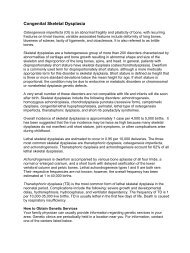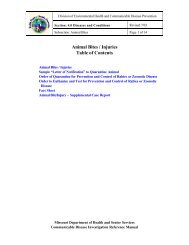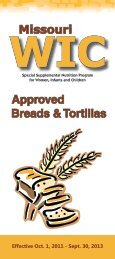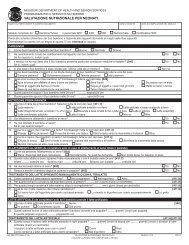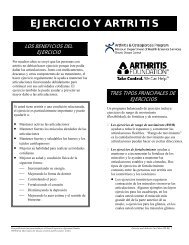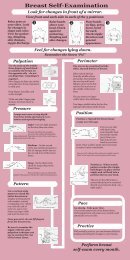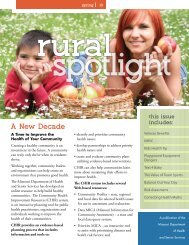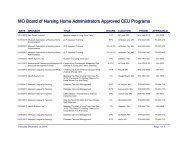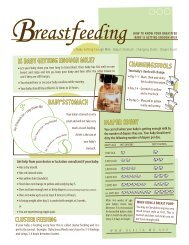Prevention and Control of Communicable Diseases - Missouri ...
Prevention and Control of Communicable Diseases - Missouri ...
Prevention and Control of Communicable Diseases - Missouri ...
Create successful ePaper yourself
Turn your PDF publications into a flip-book with our unique Google optimized e-Paper software.
General information<br />
July 2011<br />
INFECTION CONTROL RECOMMENDATIONS FOR<br />
SCHOOL ATHLETIC PROGRAMS<br />
Students participating in school athletic programs may have increased risk <strong>of</strong> infection because <strong>of</strong> skin-toskin<br />
contact or through the sharing <strong>of</strong> water bottles, athletic equipment, <strong>and</strong> towels. To minimize the risk<br />
<strong>of</strong> infection:<br />
� Exclude athletes with non-intact skin (e.g., boils, sores, cuts, etc.) from competition or practice until<br />
evaluated by a healthcare provider.<br />
� Exclude athletes with head lice from activities where there is head-to-head contact or headgear is used<br />
until they are treated.<br />
� Ensure that all athletes have their own water bottles <strong>and</strong> discourage the sharing <strong>of</strong> water bottles.<br />
� Provide clean towels for athletes during practice <strong>and</strong> competition to minimize contact with the saliva<br />
<strong>and</strong> secretions <strong>of</strong> others.<br />
� Encourage all persons to wear shower shoes, s<strong>and</strong>als, or flip-flops in the shower or the locker room to<br />
prevent the spread <strong>of</strong> fungal infections (athlete’s foot) <strong>and</strong> plantar warts.<br />
� Inform athletes that items such as toothbrushes, razors, <strong>and</strong> nail clippers might be contaminated with<br />
blood <strong>and</strong> should not be shared.<br />
� Cover breaks in skin with a water-pro<strong>of</strong> b<strong>and</strong>age. Change b<strong>and</strong>age if it gets wet.<br />
� Have athletes shower after every practice/game. DO NOT share towels.<br />
Possible blood exposure<br />
Participation in sports may result in injuries in which bleeding occurs. The following recommendations<br />
have been made for sports in which direct body contact occurs or in which an athlete’s blood or other<br />
body fluids visibly tinged with blood may contaminate the skin or mucous membranes <strong>of</strong> other<br />
participants or staff:<br />
� Have athletes cover existing cuts, abrasions, wounds, or other areas <strong>of</strong> broken skin with an occlusive<br />
dressing (one that covers the wound <strong>and</strong> contains drainage) before <strong>and</strong> during practice <strong>and</strong>/or<br />
competition. Caregivers should cover their own non-intact skin to prevent spread <strong>of</strong> infection to or<br />
from an injured athlete.<br />
� Wear disposable gloves to avoid contact with blood or other body fluids visibly tinged with blood <strong>and</strong><br />
any object such as equipment, b<strong>and</strong>ages, or uniforms contaminated with these fluids. H<strong>and</strong>s should<br />
be thoroughly cleaned with soap <strong>and</strong> water or an alcohol-based h<strong>and</strong> rub as soon as possible after<br />
gloves are removed.<br />
� Remove athletes with active bleeding from competition as soon as possible <strong>and</strong> until the bleeding has<br />
stopped. Wounds should be cleaned with soap <strong>and</strong> water. Skin antiseptics may be used if soap <strong>and</strong><br />
water are not available. Wounds must be covered with an occlusive dressing that remains intact<br />
during further play before athletes return to competition.<br />
62



